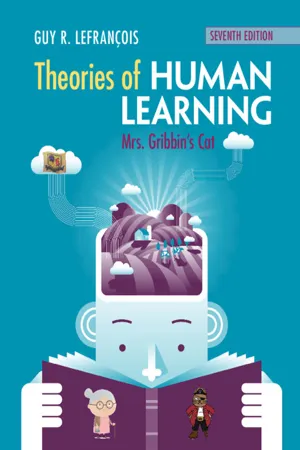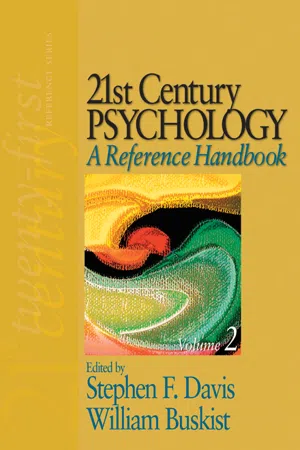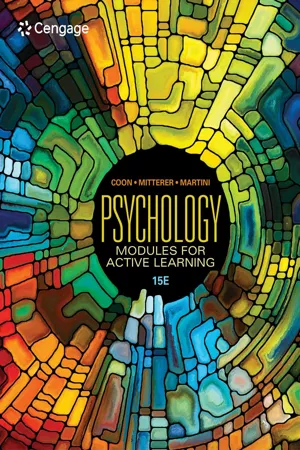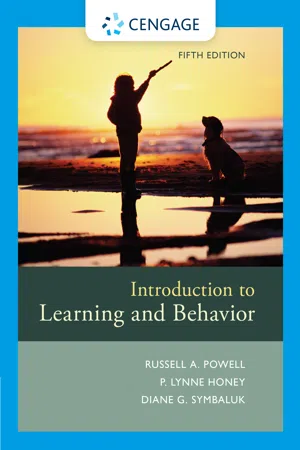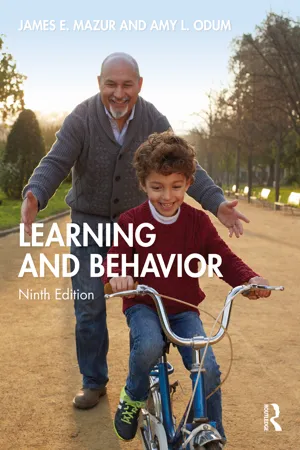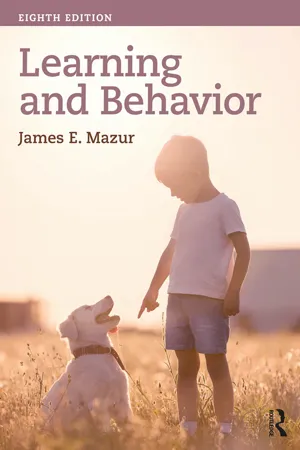Psychology
Operant Conditioning Applications
Operant conditioning applications involve using reinforcement and punishment to modify behavior. In real-world settings, this can be seen in various forms such as parenting techniques, classroom management strategies, and workplace behavior modification programs. By understanding and applying the principles of operant conditioning, individuals and organizations can effectively shape and influence behavior.
Written by Perlego with AI-assistance
Related key terms
1 of 5
7 Key excerpts on "Operant Conditioning Applications"
- eBook - PDF
Theories of Human Learning
Mrs Gribbin's Cat
- Guy R. Lefrançois(Author)
- 2019(Publication Date)
- Cambridge University Press(Publisher)
My stomach rumbled. Practical Applications of Operant Conditioning 147 learning principles are also labeled behavior therapy (a term used mainly for the application of Pavlovian principles) or behavior modification (used more for the application of operant conditioning principles). Many different conditioning-based behavior management techniques have been developed. Four of the most common are described briefly here. Positive Reinforcement and Punishment As we have just seen, positive reinforcement and punishment – including things such as praise, work bonuses, social approval or time-out procedures, reprimands, penalties, and so on – can be highly effective for modifying behavior and are widespread in everyday life. Research indicates that specific, well-planned behavior management strategies are typically more effective than are more informal, less-organized approaches. The most effective of these programs are often those based on positive rather than aversive contingencies. When these programs are based on positive reinforcement, they often use tokens as reinforcers. Typically, these can later be exchanged for more meaningful reinforcement (Eby & Greer, 2017). Money is an especially effective token. Counterconditioning As we saw in Chapter 2, Guthrie describes how some undesirable habits that have been conditioned to certain stimuli can sometimes be replaced with different, incompatible responses to the same stimuli through a process called counterconditioning – a procedure whereby an undesirable response is replaced with one that is more acceptable. Counterconditioning is sometimes used in psychotherapy – the treatment of mental dis- orders and emotional problems. As we saw in Chapter 2, counterconditioning is well illustrated in systematic desensitization, which is used mainly for treating anxieties and phobias (fears). Counterconditioning procedures have also been successfully used in the medical field. - Stephen F. Davis, William Buskist, Stephen F. Davis, William F. Buskist(Authors)
- 2007(Publication Date)
- SAGE Publications, Inc(Publisher)
The scope of operant conditioning has widened from studying the behaviors of Skinner’s rats and pigeons to an array of complex human behaviors, such as reducing problem behaviors in children, making the workplace safer, and understanding and combating drug‑use behavior. In addition to his contributions to behaviorism and operant conditioning, Skinner’s work led to the found‑ ing of two important psychological journals: the Journal of Experimental Analysis of Behavior (1958) and the Journal of Applied Behavior Analysis (1968). In addition to the well‑known operant chamber, Skinner also invented several other novel apparatuses, including the cumula‑ tive recorder, the baby‑tender, and the teaching machine. Finally, Skinner produced many notable writings, which remain influential today in the field of psychology. Among such writings are The Behavior of Organisms Operant Conditioning • 331 (1938), Schedules of Reinforcement (with C. B. Ferster, 1957), and Verbal Behavior (1957). One book, Walden Two , describes a utopian society based on the application of operant principles to everyday living (Skinner, 1948). OPERANT CONDITIONING What Is an Operant? The term operant refers simply to a behavior that is changed as a result of its consequences (Millenson & Leslie, 1979). The term conditioning refers to a specific type of learning. Thus, operant conditioning is learning produced as a result of behavioral consequences. More specifically, operant conditioning is behavior change that results from the association between or among responses and their consequences. The more frequently an operant occurs, the stronger it becomes (Skinner, 1938). The Three-Term Contingency Behavior does not occur in a vacuum; certain envi‑ ronmental events usually precede and follow behavior. Consider, for example, the practice of answering the tele‑ phone. The phone rings, you pick it up and say “hello” into the mouthpiece, and a person on the other end of the line begins to speak.- eBook - PDF
- Catherine A. Sanderson, Karen R. Huffman(Authors)
- 2019(Publication Date)
- Wiley(Publisher)
Real World Application Question [AQ3] Why do gamblers have such trouble quitting, even when they continue to lose money? Motortion Films/ Shutterstock.com blue jean images/Getty Images 180 CHAPTER 6 Learning As we’ve just seen, classical conditioning is based on what happens before we involuntarily respond: Something happens to us, and we learn a new response. In contrast, operant con- ditioning is based on what happens after we voluntarily perform a behavior (Cooper et al., 2019; Pear, 2016). We do something and learn from the consequences. Be sure to note that when a behavior is followed by reinforcement, it increases. When it’s followed by punishment, it decreases (Figure 6.7). The key point to remember is that consequences are the heart of operant conditioning (see cartoon). In classical conditioning, con- sequences are irrelevant—Pavlov’s dogs still got to eat whether they salivated or not. But in operant conditioning, the organism voluntarily performs a behavior (an operant) that produces a consequence—either reinforcement or punishment—and the behavior either increases or decreases. It’s also very important to note that reinforcement is the process by which adding or taking away a stimulus following a response increases the likelihood that the response will be repeated. Punishment, in con- trast, is the process by which adding or taking away a stimulus following a response decreases the likelihood that the response will be repeated. The power and problems with reinforcement and punishment will be explored later in this section. For now we want to highlight how they can be used to improve your everyday life. For example, allowing your- self to watch TV only while exercising is a form of reinforcement that will improve your general physical health. - eBook - PDF
Psychology
Modules for Active Learning
- Dennis Coon, John Mitterer, Tanya Martini, , Dennis Coon, John Mitterer, Tanya Martini, (Authors)
- 2021(Publication Date)
- Cengage Learning EMEA(Publisher)
Operant Conditioning—Send in the Reinforcements After reading this module you should be able to: 28.1 Explain how operant conditioning works, predict how positive and negative reinforcement and punish-ment will impact the likelihood that a behavior will be repeated, distinguish between generalization and discrimination in operant conditioning, and explain how shaping works 28.2 Name three factors that impact the effectiveness of reinforcement and punishment, differentiate between continuous and partial schedules of reinforcement, and name the four types of partial schedules of reinforcement 28.3 Contrast primary and secondary reinforcers and briefly discuss two instances of operant conditioning in everyday life ~LEARNING OUTCOMES~ In this module we discuss operant conditioning in some detail. Operant conditioning (sometimes called instrumental conditioning ) is based on the consequences of responding. The basic principle is simple: Acts that are followed by a Operant (instrumental) conditioning Learning based on the positive or negative consequences of responding. Copyright 2022 Cengage Learning. All Rights Reserved. May not be copied, scanned, or duplicated, in whole or in part. Due to electronic rights, some third party content may be suppressed from the eBook and/or eChapter(s). Editorial review has deemed that any suppressed content does not materially affect the overall learning experience. Cengage Learning reserves the right to remove additional content at any time if subsequent rights restrictions require it. PSYCHOLOGY MODULES FOR ACTIVE LEARNING 238 positive consequence tend to be repeated (Lefrançois, 2012). A dog is much more likely to keep searching for food under a pillow if it finds food there (positive consequence). The dog will likely stop looking there if it fails to find food (no consequence) or finds something frightening (negative con-sequence). - eBook - PDF
- Russell Powell, P. Honey, Diane Symbaluk, , Russell Powell, P. Honey, Diane Symbaluk(Authors)
- 2016(Publication Date)
- Cengage Learning EMEA(Publisher)
Thus, operant conditioning is sort of a mini-evolution of an organism ’ s behaviors, in which behaviors that are adaptive (lead to favorable outcomes) become more frequent while behaviors that are nonadaptive (do not lead to favorable outcomes) become less frequent. The operant conditioning process can be conceptualized as involving three components: (1) a response that produces a certain consequence (e.g., lever press-ing produces a food pellet), (2) the consequence that serves to either increase or decrease the probability of the response that preceded it (e.g., the consequence of a food pellet increases the rat ’ s tendency to again press the lever), and (3) a discrim-inative stimulus that precedes the response and signals that a certain consequence is now available (e.g., a tone that signals that a lever press will now produce food). These components are examined in more detail below. Operant Behavior An operant behavior is a class of emitted responses that result in certain con-sequences; these consequences then affect the future probability or strength of those responses. Operant responses are sometimes simply called operants . Suppose, for example, that a rat presses a lever and receives a food pellet, with the result that it is more likely to press the lever in the future. Lever press ã Food pellet The effect : The future probability of lever pressing increases. Or Jonathan might tell a joke and receive a frown from the person he tells it to. He is now less likely to tell that person a joke in the future. Tell a joke ã Person frowns The effect: The future probability of telling a joke decreases. In each case, the behavior in question (the lever pressing or the joke telling) is an operant response (or an “ operant ” ) because its occurrence results in a certain consequence and that consequence affects the future probability of the response. - eBook - ePub
- James E. Mazur, Amy L. Odum(Authors)
- 2023(Publication Date)
- Routledge(Publisher)
CHAPTER 5 Basic Principles of Operant Conditioning DOI: 10.4324/9781003215950-5 Learning Objectives After reading this chapter, you should be able to describe Thorndike’s Law of Effect and experiments on animals in the puzzle box discuss how the principle of reinforcement can account for superstitious behaviors describe the procedure of shaping and explain how it can be used in applied behavior analysis explain B. F. Skinner’s free-operant procedure, three-term contingency, and the basic principles of operant conditioning define instinctive drift and explain why some psychologists believed that it posed problems for the principle of reinforcement define autoshaping and discuss different theories about why it occurs. Unlike classically conditioned responses, many everyday behaviors are not elicited by a specific stimulus. Behaviors such as walking, talking, eating, drinking, working, and playing do not occur automatically in response to any particular stimulus. In the presence of a stimulus such as food, an animal might eat or it might not, depending on the time of day, the time since its last meal, the presence of other animals, and so on. Because it appears that the animal can choose whether to engage in behaviors of this type, people sometimes call them “voluntary” behaviors and contrast them with the “involuntary” behaviors that are part of unconditioned and conditioned reflexes. Some learning theorists state that whereas classical conditioning is limited to involuntary behaviors, operant conditioning influences our voluntary behaviors. The term voluntary may not be the best term to use because it is difficult to define in a precise, scientific way, but whatever we call nonreflexive behaviors, this chapter should make one thing clear: Just because there is no obvious stimulus preceding a behavior, this does not mean that the behavior is unpredictable - eBook - ePub
Learning & Behavior
Eighth Edition
- James E. Mazur(Author)
- 2016(Publication Date)
- Routledge(Publisher)
Chapter 5 Basic Principles of Operant Conditioning Learning Objectives After reading this chapter, you should be able to describe Thorndike’s Law of Effect and experiments on animals in the puzzle box discuss how the principle of reinforcement can account for superstitious behaviors describe the procedure of shaping and explain how it can be used in behavior modification explain B. F. Skinner’s free-operant procedure, three-term contingency, and the basic principles of operant conditioning define instinctive drift, and explain why some psychologists believed that it posed problems for the principle of reinforcement define autoshaping and discuss different theories about why it occurs Unlike classically conditioned responses, many everyday behaviors are not elicited by a specific stimulus. Behaviors such as walking, talking, eating, drinking, working, and playing do not occur automatically in response to any particular stimulus. In the presence of a stimulus such as food, an animal might eat or it might not, depending on the time of day, the time since its last meal, the presence of other animals, and so on. Because it appears that the animal can choose whether to engage in behaviors of this type, people sometimes call them “voluntary” behaviors and contrast them with the “involuntary” behaviors that are part of unconditioned and conditioned reflexes. Some learning theorists state that whereas classical conditioning is limited to involuntary behaviors, operant conditioning influences our voluntary behaviors. The term voluntary may not be the best term to use because it is difficult to define in a precise, scientific way, but whatever we call nonreflexive behaviors, this chapter should make one thing clear: Just because there is no obvious stimulus preceding a behavior, this does not mean that the behavior is unpredictable
Index pages curate the most relevant extracts from our library of academic textbooks. They’ve been created using an in-house natural language model (NLM), each adding context and meaning to key research topics.
